Ministerial contacts
The Honourable Pablo Rodriguez,
Minister of Transport
TC.MinisterofTransport-MinistredesTransports.TC@tc.gc.ca
Parliamentary Secretary

Parliamentary Secretary to the Minister of Transport
Arun Thangaraj - Deputy Minister 

Deputy Minister's Office
People10
- Caceres, Jaime; ADM, Corporate Services and Chief Financial Officer;
- Carmichael, Shannon; Executive Advisor;
- Desloges, Jessica; 343-575-6186; A/Executive Advisor;
- McConkey, Amanda; A/Administrative Services Coordinator;
- McKay, Martin; 778-836-3065; RDG - Pacific;
- Santiago, Marcia; DG Special Projects;
- Sauvé, Désirée; 613-513-3907; Chief of Staff;
- St-Jacques, Kim; Senior Coordinator to the Deputy Minister;
- Thangaraj, Arun; 613-990-4509; Deputy Minister;
- Tymko, Jenna-Marie; Manager, Resources and Management Services;
Brigitte Diogo
Education
Bachelor of Social Sciences (Honours), Political Science, University of Ottawa
Bachelor of Social Sciences, Economics and Public Policy, University of Ottawa
Professional Experience
Since April 2022
Deputy Commissioner of the Canada Revenue Agency
2020 - 2022
Vice-President, Health Security and Regional Operations Branch, Public Health Agency of Canada
2015 - 2020
Director General, Rail Safety, Transport Canada
2011 - 2014
Director of Operations, Security and Intelligence Secretariat, Privy Council Office
2008 - 2011
Director of Operations, Economic and Regional Development Policy Secretariat, Privy Council Office
2005 - 2007
Director General, Risk Mitigation Branch, Citizenship and Immigration Canada
2001 - 2005
Chief of Staff to the Deputy Minister, Deputy Minister’s Office, Citizenship and Immigration Canada
Office of the Corporate Secretary
- Armstrong, Jean-Christophe; Unknown;
- Badawey, Vance; Unknown;
- Borges, Helena; 613-949-2960; Special Advisor to the Deputy Minister;
- Brackenridge, Jimmy M; 613-852-5763; Director General and Corporate Secretary;
- Bruyère, Julie; Corporate Secretariat Issues Officer;
- De Casanove, Laurent; PRESS SECRETARY;
- Diogo, Brigitte; 613-998-8697; Associate Deputy Minister;
- Duran, Anson; Chief of Staff ;
- Edouard, Georges GE; 343-543-7035; Corporate Secretariat Issues Officer;
- Ghadban, Yasmein; 343-572-3909; Manager, Executive Operations;
- Gougeon, Carolyne; Coordinator to the Associate Deputy Minister;
- Marcotte, Natalie; 613-558-7590; Corporate Secretariat Issues Officer;
- Molina, Michelle; Unknown;
- Morin, Marie-Pier; 343-553-9867; Corporate Secretariat Issues Officer;
- Pham, Nhi; Unknown;
- Pilon, Olivier; Special Assistant;
- Sauve Chartrand, Becky; Administrative Assistant;
- Storing, Samantha; Administrative Services Coordinator;
- Watson, Sarah; 343-553-3044; Corporate Secretariat Issues Officer;
Feds confirm Via Rail will replace entire fleet of trains, no clarity on fixing N.B. tracks
Transport minister reiterates modernization plan; transport advocate says tracks should come first
The federal government has confirmed it's pressing ahead with plans to replace Via Rail's entire fleet of trains, but a New Brunswick advocacy group says new tracks are needed in the province first.
Ted Bartlett, former president of Transport Action Atlantic — a public transport advocacy group — said the tracks in New Brunswick are deteriorating.
He attended the federal announcement in Moncton on Thursday afternoon and said he was happy to learn the government was reiterating its commitment to replace the Crown corporation's entire fleet of passenger trains, which date as far back as the 1950s.
However, in an post-announcement interview Bartlett said Transport Canada should start talking to CN Rail to fix the aging tracks in New Brunswick.
 Past
president Ted Bartlett (left), and Tim Hayman, the current president of
Transport Action Atlantic, stand in front of a Via Rail train that
dates back to around the 1950s. (Submitted by Ted Bartlett)
Past
president Ted Bartlett (left), and Tim Hayman, the current president of
Transport Action Atlantic, stand in front of a Via Rail train that
dates back to around the 1950s. (Submitted by Ted Bartlett)
"The snail's pace at which the train must move between Moncton and Campbellton is a national embarrassment, or it certainly should be. We need to fix this and we need to fix it now.
"The newest and shiniest train cars in the world won't attract riders if they have to crawl along at 30 miles an hour," he said.
Federal Minister of Transportation Pablo Rodriguez said his department is aware of the challenges.
He said his department talks with CN "all the time about safety, security, about tracks, about speed, about all kinds of stuff.
"It's a very regulated industry and Transport Canada plays a major role with them. So we speak on a daily basis," he said.
Over 300 train cars and more than 40 locomotives will be replaced across the country's passenger train network, Rodriguez said.
Officials did not say how much the project is expected to cost.
The announcement comes months after the federal government tabled its 2024 budget, which included money for Via Rail to replace its fleet "on routes outside the Québec City-Windsor Corridor," according to a news release from Transport Canada on Thursday.
 Officials announced in late June that new Via Rail train cars had arrived in Windsor. (Jacob Barker/CBC)
Officials announced in late June that new Via Rail train cars had arrived in Windsor. (Jacob Barker/CBC)
Rodriguez would not discuss the state of his department's conversations with CN about New Brunswick's railway tracks, but acknowledged that delays are "a challenge across the country."
Bartlett said the government needs to take leadership on the issue and if they do, the tracks can be fixed in a couple of years.
He said the tracks move very little freight for CN, but for New Brunswickers the delays are "always an uneasy feeling."
"You tend to worry a bit if you're going to make your connection in Montreal," he said.
Rita Toporowski, the chief service delivery officer at Via Rail, said the new fleet will open new on-board service opportunities for the Crown corporation.
 Rita
Toporowski, the chief service delivery officer at Via Rail Canada, says
the new fleet will present new opportunities for on-board service. (Rhythm Rathi/CBC)
Rita
Toporowski, the chief service delivery officer at Via Rail Canada, says
the new fleet will present new opportunities for on-board service. (Rhythm Rathi/CBC)
She said the new fleet will be procured through a global tender bidding process, which could take a lot of time.
"You are talking a lengthy period, you're talking years," she said, citing a complicated negotiation and testing process.
"Our mandate is to serve Canadians right across Canada and we do have lots of communities that are always interested in more service."
Via Rail trip between Halifax, Montreal to take longer due to poor rail conditions
Via Rail says the change will provide passengers 'with a schedule that better represents actual travel times'
Train travellers between Halifax and Montreal will now spend more time on the rails, partly due to a lack of upkeep on the tracks in northern New Brunswick.
Officials with Via Rail say the eastbound Ocean train trip from Montreal to Halifax will take an extra 45 minutes, while the westbound trip from Halifax to Montreal will be 90 minutes longer.
"In response to recurring slow orders imposed by CN, along with a deterioration of operational speeds on that infrastructure due to track conditions, notably on the Newcastle subdivision, Via Rail has no choice but to adjust the schedule of the Ocean, starting June 19, to provide passengers with a schedule that better represents actual travel times," an official said in an emailed statement to CBC News.
The Newcastle subdivision is a 278-kilometre stretch of track owned by CN Rail that runs from central to northern New Brunswick. Via Rail said it gave more than $18 million to CN in 2014 for repairs of a 71-kilometre section of the subdivision between Bathurst and Miramichi.
 Via Rail's Ocean line makes several stops between Halifax and Montreal. (Via Rail)
Via Rail's Ocean line makes several stops between Halifax and Montreal. (Via Rail)
"These funds were spent exceptionally to maintain status quo for passenger rail service levels on the Ocean, as CN was considering the abandonment of that portion of the subdivision," the statement said. "Unfortunately, the current conditions of that same infrastructure have now led to some operational changes."
The poor rail conditions are forcing trains to slow down to about 50 kilometres per hour, according to Transport Action Atlantic, an organization that advocates for the development of and advancement of public transportation in the region. The group also said that 30 years ago, the route had permissible speeds of up to 120 km/h over much of the track.
"It certainly was well travelled because it was a much more frequent service to begin with, but it was also much more reliable and it was a whole lot faster than it is now," said Ted Bartlett, former president of Transport Action Atlantic.
"We're not talking high-speed rail here. We're talking 19 hours and 15 minutes from Halifax to Montreal. But that's a heck of a lot better than it is now."
He said because of the disrepair, trains are forced to "crawl" over some stretches at speeds "no faster than a walk."
According to the Via Rail website, the trip takes an average of more than 23 hours from city to city, with three departures a week. The westbound train from Halifax is scheduled to leave at 11:30 a.m. AT and arrive in Montreal close to 11 a.m. AT the next day. A change in departure time and the lengthened duration makes the trip less appealing to business travellers, Bartlett said. He said 30 years ago, the train left Halifax around 2 p.m. AT and arrived in Montreal the next day around 9:15 a.m. AT, giving travellers more flexibility.
 Ted Bartlett is the former president of Transport Action Atlantic. (Alexandre Silberman/CBC)
Ted Bartlett is the former president of Transport Action Atlantic. (Alexandre Silberman/CBC)
"Really, this is a failure of transportation policy in Canada by successive governments," he said. "We won't blame the current government, its predecessors were just as bad," he said. "They totally ignored passenger rail."
The line itself is not owned by Via Rail, but by CN, a former Crown corporation that was privatized in 1995. In Bartlett's estimation, the lack of investment into passenger rail is about "shareholder value."
"And there's no shareholder value in investing in a track that's as lightly used as the Newcastle subdivision. So CN isn't going to do anything about it."
When asked about the condition of the tracks in the subdivision, CN spokesperson Ashley Michnowski said in an email that the corporation's ongoing maintenance of the area "will allow for some improvement to speed restrictions in the coming weeks and months."
Michnowski said CN invested roughly $22 million last year in maintenance to more than 950 kilometres of track in New Brunswick, including the Newcastle subdivision, and it carries out regular maintenance on its network "to the extent it is commercially reasonable."
Expert says passenger rail needs support from government
Gordon Lovegrove said that more investment in train travel in Canada could be a boon financially and environmentally.
"There's a really good business case for passenger rail in Canada, given we need to take some urgent drastic action to reduce the amount of emissions into the climate, into the atmosphere," he said.
Lovegrove, an associate professor in the School of Engineering at the University of British Columbia, said while passenger rail isn't a "panacea" for travel issues, it does offer some affordable and safe solutions.
Like Bartlett, Lovegrove said because most railway companies in the country are privately owned, they tend to be motivated by the bottom line.
"Transportation is a social determinant of health, and private, profit-motivated companies are looking at direct costs and benefits to themselves and nobody else, not the general public," Lovegrove said.
"I think the government has to step in and say, 'Listen, are we doing this? Are we getting on board the national and international and provincial climate action bandwagon or are we not doing this?'"
Pablo Rodriguez takes over as Minister of Transport
On July 26, the federal government carried out a major cabinet reshuffle, which included appointing Pablo Rodriguez as Minister of Transport. He is the Member of Parliament for Honoré-Mercier in Montreal.
He takes over from Omar Alghabra, who had served as minister since January 12, 2021. Omar Alghabra’s tenure including confirming the government’s intention to start procurement on High Frequency Rail and make it electrified, setting up VIA-HFR as a separate entity, and initiating a new study of rail service enhancements in Southwestern Ontario. His team also worked with VIA Rail to advance the first stages of procurement for the replacement of the long distance and remote service fleet. His tangible achievements include delivering funding for needed station repairs in the Quebec-Windsor corridor and additional funding to proceed with the maintenance centre modernization projects needed to support VIA Rail’s new fleet.
Pablo Rodriguez previously served as Minister of Canadian Heritage, and is also Liberals’ “Quebec lieutenant.” He has regularly appeared alongside Omar Alghabra at transportation announcements.
Transport Action Canada has written to Minister Rodriguez, welcoming him to the new role and also highlighting the opportunities to rapidly advance the government’s work to improve mobility across Canada.
About Us
Founded as Transport 2000 Canada in 1977, we are a non-profit, citizen-based organization that promotes sustainable transport through advocacy and education. We are concerned with all modes of public transport, such as intercity passenger train and bus service, aviation including air safety, and urban transit. Our association functions as a consumer-based advocacy group, compared to transport industry based bodies such as the Railway Association of Canada or the Canadian Urban Transit Association. We regularly communicate with government and industry officials–such as Transport Canada and elected officials of all government levels–to promote and advocate for sustainable transportation. Canadian news media agencies frequently interview our contributing members on transportation matters.
What do we represent for consumers?
We represents the interests of consumers or users of public transport services in Canada and is involved with a variety of transport issues including:
- the development of rail passenger services in Canada;
- the future of inter-city bus services and their connectivity to rail and air services;
- urban and commuter transit systems;
- the implications to consumers of the deregulated airline industry in Canada;
- the role of marine and coastal services;
- the effects of and alternatives to rail branch line abandonments;
- the role of government regulation in all public transportation;
- the impact on the public interest of demands for new highway spending;
- the safety of passenger and freight rail, air and other public carriers;
- the promotion of intermodal links to improve the accessibility and cost-efficiency of public transport.
What is our philosophy towards transportation?
We believe that transportation is more than just a means of moving goods and people, measured only by profits or political benefits. Transportation is a tool to protect the environment, conserve energy, diminish land pressures, curtail the growth of road and highway spending and promote economic growth. Public transportation impacts our land use, economic development and quality of life. It also determines accessibility to housing, education, health services, employment and leisure. Some groups are affected more than others by the availability and quality of public transportation: youth, the disabled, seniors, the poor, the unemployed, and those who live in rural and remote areas. Simply put: Accessible and well-developed transportation system in all regions will lead to a better quality of life for all Canadians. That is our philosophy. It is what we have been advocating for the last 40+ years, and it is what will keep us continuing what we do.
Another setback for VIA Rail’s Ocean
There’s been yet another blow to the last remnant of passenger rail service in the Maritimes. VIA Rail has announced a schedule change effective June 19 that officially adds 90 minutes to the travel time of the Ocean between Halifax and Montreal. The adjustment is being made to compensate for badly deteriorated track conditions on CN’s Newcastle Subdivision in northern New Brunswick.
“VIA is simply recognizing the reality that the speed restrictions imposed by CN make it impossible for the Ocean to maintain its currently published schedule,” says Transport Action Atlantic president Tim Hayman. “As a result, connections to Toronto, Ottawa, and other points west of Montreal have become less reliable. For passengers heading east, it is a frequent occurrence for the train to be running between two and three hours late, and this lack of reliability is clearly unacceptable.
“Unfortunately VIA apparently has no other choice but to pad and adjust its schedule. There is no indication of any plans by the infrastructure owner to restore the track to its previous standards. The result is a total journey time far longer than any in recent memory – more than 23 hours from Halifax to Montreal. This is most certainly not consistent with VIA’s recently-announced strategy of improving passenger rail for all Canadians.”
Effective June 19, the Ocean will be departing Halifax at 1130, instead of 1300 as has been the case in recent years. The extra 90 minutes in the schedule is expected to make connections at Montreal more reliable and allow the eastbound train to maintain its schedule by retiming the overnight meet between the two trains, but will not address the root cause of the problem.
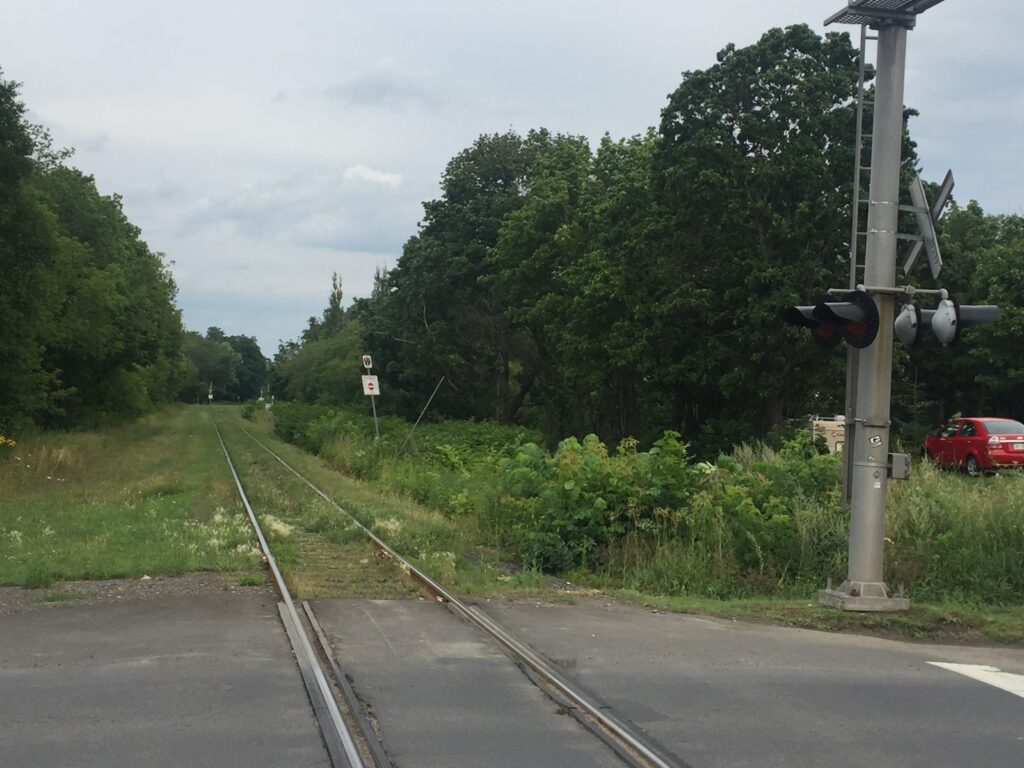 A
look at overgrown track on a section of the Newcastle Subdivision near
Campbellton NB several years ago. Ongoing neglect of this line and
ensuing slow orders have forced this latest lengthening of the Ocean’s
schedule. PHOTO – Ted Bartlett
A
look at overgrown track on a section of the Newcastle Subdivision near
Campbellton NB several years ago. Ongoing neglect of this line and
ensuing slow orders have forced this latest lengthening of the Ocean’s
schedule. PHOTO – Ted Bartlett
“This is yet another example of how transportation policy of successive federal governments is failing Canadians,” says TAA past president Ted Bartlett. “It will now take nearly five hours longer to travel from Halifax to Montreal than it did 30 years ago. And while we are encouraged to see that Ottawa’s recent budget is making provision to begin replacing the aging fleet of long-haul passenger cars and locomotives, this by itself is not sufficient. There are serious infrastructure issues that must also be addressed, because new equipment will still be subject to the same speed restrictions on this deteriorated track. Frankly, this situation is a national embarrassment.”
Under the revised timetable, the westbound Ocean will require 6 hours and 16 minutes to travel the 186 miles (300 km) of mostly sub-standard track from Moncton to Campbellton – an average speed of less than 30 miles per hour. (In keeping with standard North American railroad practice, track distance and speeds continue to be stated in miles.) Thirty years ago the route was covered in just over four hours, with permissible speeds of up to 75 mph over much of the trackage. A lack of maintenance over the years has resulted in steady deterioration and numerous speed restrictions to ensure safe operation.
“Transport Action Atlantic believes there are three key pillars to ensuring a healthy future for what remains of passenger rail in our region,” says Tim Hayman. “VIA Rail urgently needs new locomotives and cars to replace its old and outdated equipment; there must be investment to restore the track infrastructure to the reasonable standards it once maintained; and the service must operate daily with faster and reliable schedules that meet or exceed those that the Ocean was historically known for.”
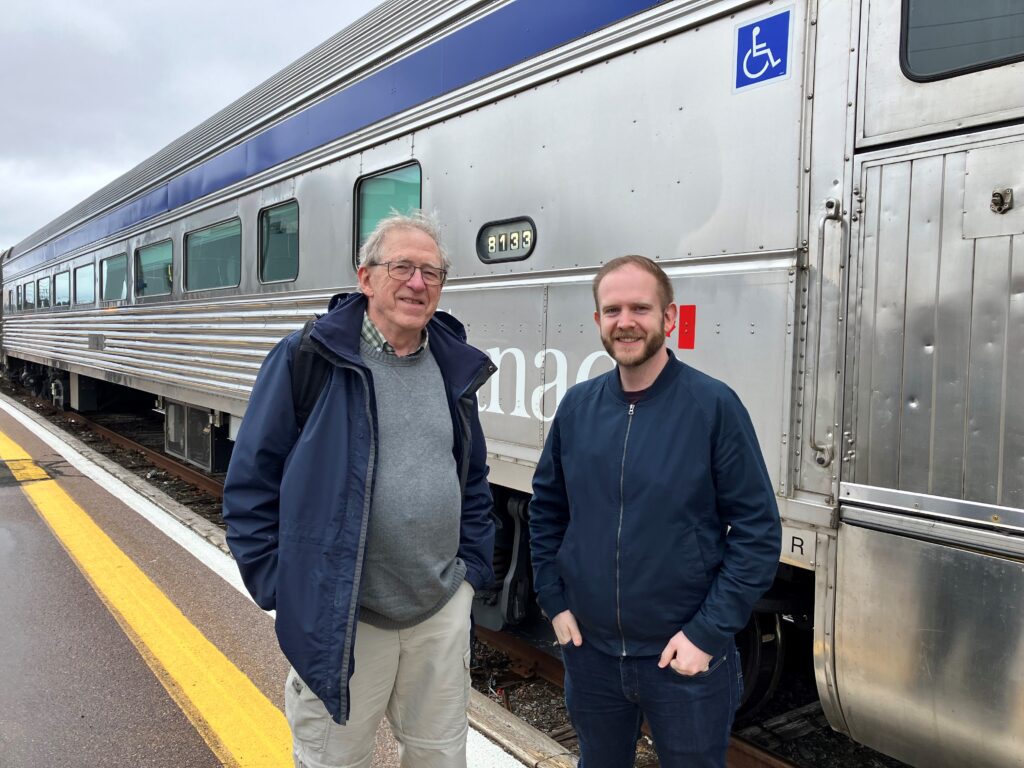 Tim
Hayman (r.) and Ted Bartlett stand beside VIA’s Ocean on the Moncton
station platform on April 29, 2024. The 78-year-old coach behind them is
among the oldest in VIA’s fleet, having been built for the New York
Central Railroad in 1946.
Tim
Hayman (r.) and Ted Bartlett stand beside VIA’s Ocean on the Moncton
station platform on April 29, 2024. The 78-year-old coach behind them is
among the oldest in VIA’s fleet, having been built for the New York
Central Railroad in 1946.
Here is the revised (and lengthened) schedule for trains 14 and 15, effective June 19, 2024:
For reference and nostalgia, here’s a look back at the VIA timetable from 30 years ago – effective 24 April 1994 – showing the Ocean departure from Halifax at 1400 and arrival in Montreal at 0815, for a total running time 19 hours, 15 minutes. We’re a far cry from that today, not to mention the absence of the other trains on this timetable!
TAA past president Ted Bartlett was on the Todd Veinotte show on June 4th to talk about this schedule change. You can listen to his interview, beginning at the 10:04 minute mark here: https://halifax.citynews.ca/2024/06/04/the-todd-veinotte-show-june-4th-10am/
The Bulletin is published twice a year by Transport Action Atlantic
Box 268, Dartmouth NS B2Y 3Y3 atlantic@transportaction.ca
Editorial Committee: Don MacLeod, Tim Hayman and Ted Bartlett
TAA Executive
Ted Bartlett President Moncton NB (506) 386-3615
Tim Hayman Vice-president /webmaster Halifax NS (902) 818-9948
Donald MacLeod Treasurer Halifax NS (902) 876-7960
Michael Perry Secretary Fredericton NB (506) 459-7330
Christine Mills Garnet Membership Secretary Dartmouth NS (902) 405-3714
Board Members
Ashley Morton Halifax NS Marcus Garnet Dartmouth NS
Allan MacDonald Antigonish NS Tom Beckett St. John’s NL
Stan Choptiany Saint Andrews NB John Cormier Charlottetown PEI
Special Advisors Howard Easton, Moncton NB; Yves Bourgeois, Shippagan NB; and
David Gunn, West Bay NS
www.transportactionatlantic.ca
Executive Team
VIA Rail’s executive team is comprised of individuals who demonstrate integrity, diligence, and know-how. Through their leadership and expertise, they help VIA Rail achieve its vision of being a smarter way to move people.
Minister of Transport announces appointment of President and Chief Executive Officer of VIA Rail Canada Inc.
News release
May 16, 2023 Ottawa, ON Transport Canada
VIA Rail Canada Inc. plays an important role in many Canadians lives, whether they use its services to travel for work, for leisure or to visit loved ones. It is also essential for many remote communities. That is why having strong leadership at the head of this organization is important to ensure the quality of its service.
Following an open, transparent, and merit-based selection process and after consultation with the Board of Directors of VIA Rail Canada Inc., the Minister of Transport, the Honourable Omar Alghabra, announces the appointment of Mr. Mario Péloquin as the President and Chief Executive Officer of VIA Rail Canada Inc. for a term of five years, effective June 12, 2023.
Mr. Péloquin has close to 40 years of experience in the transportation and rail industry. He possesses considerable executive-level experience, is an active member of his community, and brings a wide array of knowledge and expertise to this position.
Quotes
"I am pleased to announce that Mario Péloquin has accepted the appointment of President and Chief Executive Officer of VIA Rail Canada Inc. Mr. Péloquin brings considerable experience in the transportation and rail industry into his new role and is well suited to lead VIA Rail over the coming years. I wish Mr. Péloquin every success as he continues to connect Canadians, from coast-to-coast-to-coast.”
The Honourable Omar Alghabra
Minister of Transport
Quick facts
-
The Minister of Transport is responsible for appointments to 53 portfolio organizations, which include:
- 8 Crown corporations;
- 4 administrative tribunal/agencies;
- 21 Canadian Airport Authorities;
- 17 Canada Port Authorities; and
- 3 shared-governance organizations.
Contacts
Nadine Ramadan
Press Secretary
Office of the Honourable Omar Alghabra
Minister of Transport, Ottawa
Nadine.Ramadan@tc.gc.ca
Media Relations
Transport Canada, Ottawa
media@tc.gc.ca
613-993-0055
https://www.trains.com/trn/news-reviews/news-wire/peloquin-named-ceo-of-via-rail-canada/
Péloquin named CEO of VIA Rail Canada
Former MTA chief operating officer is fourth person to head VIA in four years
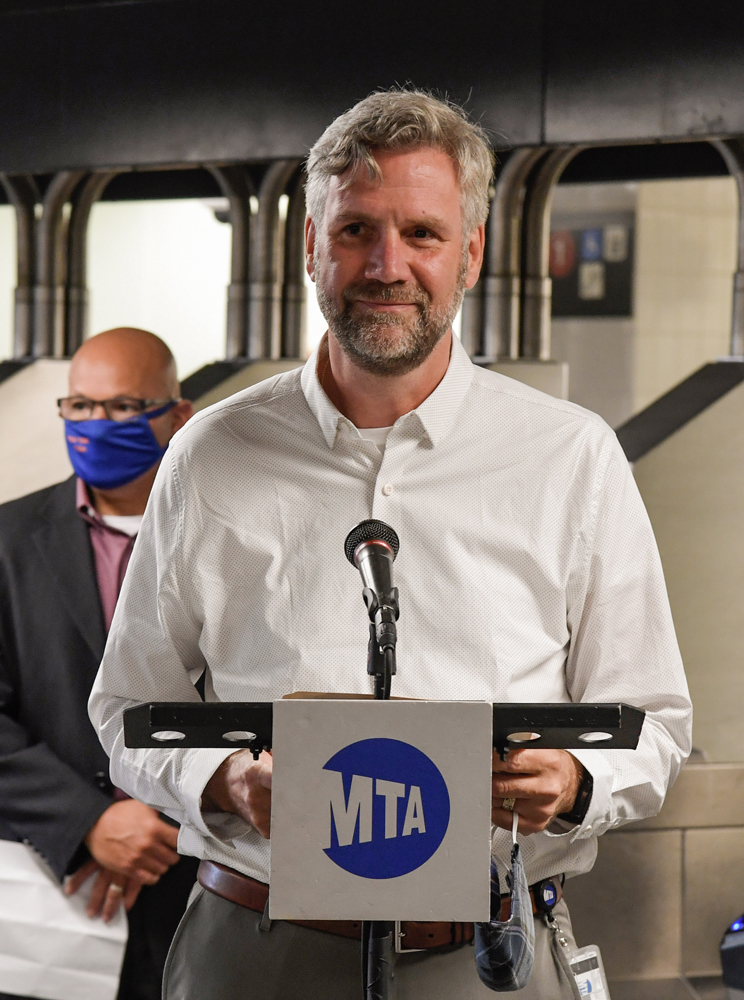
MONTREAL — Mario Péloquin will become the new president and CEO of VIA Rail Canada as of June 12, Transport Minister Omar Alghabra announced Tuesday.
Péloquin becomes VIA’s fourth CEO in four years, following Yves Desjardins-Siciliano, Cynthia Garneau, and Martin Landry, who had been CEO since May 2022.
Péloquin spent little more than a year as chief operating officer of New York’s Metropolitan Transportation Authority, being named to that position in November 2019 before returning to Canada for a position with construction firm AECON in February 2021. Most recently, he was executive vice president, major projects, with Keolis in Boston.
His lengthy rail resume includes time with Canadian National; as a senior advisor with Transport Canada; as an investigator with the Transportation Safety Board of Canada; and with Thales, Siemens, and engineering firms SNC-Lavalin and AECOM (not to be confused with more recent employer AECON).
“Mr. Péloquin brings considerable experience in the transportation and rail industry into his new role and is well suited to lead VIA Rail over the coming years,” Alghabra said in a press release. “I wish Mr. Péloquin every success as he continues to connect Canadians, from coast-to-coast-to-coast.”
Landry, the departing CEO, had previously been VIA’s chief commercial officer since May 2014. He was promoted when Garneau resigned after three years, reportedly in response to the High Frequency Rail project being shifted from VIA’s oversight to that of Transport Canada [see “VIA’s struggle for relevance at the root of CEO’s resignation: Analysis,” Trains News Wire, May 24, 2022].
https://www.ccmm.ca/en/events-ccmm/forums-and-conferences/talk-by-mario-peloquin-0524/
VIA Rail’s 2030 vision: To be at the heart of Canada’s passenger journey
Talk by Mario Péloquin, President and Chief Executive Officer of VIA Rail In-person events The speech will be delivered in French. Thursday, May 23, 2024 from 7:30 a.m. to 9:30 a.m.Registration deadline: May 21, 2024
Speaker
-
Mario Péloquin President and Chief Executive Officer
VIA Rail See biography
VIA Rail’s executive team is comprised of individuals who demonstrate integrity, diligence, and know-how. Through their leadership and expertise, they help VIA Rail achieve its vision of being a smarter way to move people.
Mario Péloquin
President and Chief Executive Officer

Mario Péloquin was appointed as President and Chief Executive Officer of VIA Rail in June 2023 and brings over 35 years of experience in the railway industry to his new role. His career trajectory started as an operator and then a rail traffic controller before he rose to hold senior roles focused on rail safety at Transport Canada and the Transportation Safety Board. Mr. Péloquin then transitioned into executive positions with global leaders such as Siemens Mobility, Aecom, Thales Canada, and the New York Metropolitan Transportation Authority, leading significant and transformative transportation projects.
Before joining VIA Rail, he held the position of Executive Vice President, Major Projects for the Paris-based Keolis Group. Mr. Péloquin believes profoundly that effective public transit is the key to solving many societal issues. His extensive experience and commitment to safety, operational efficiency, and innovative technology position him well to lead VIA Rail into a new era of innovation and operational excellence.
Mr. Péloquin holds an MBA from the Université du Québec à Montréal. He has also served on the boards of the Canadian Consortium for Urban Transportation Research and Innovation (CUTRIC), the Canadian Association of Railway Suppliers (CARS), the Toronto Railway Club, and the Canadian Urban Transit Association (CUTA)
Rita Toporowski
Chief Service Delivery Officer

Ms. Toporowski joined VIA Rail in November 2014, first as General Manager for Central Canada and then as Vice-President, Customer Experience, and Chief Customer Officer. In 2023 she was appointed Chief Service Delivery Officer where her focus is on providing overall direction and strategic leadership to all customer-focused teams, as well as VIA Rail’s Railway Operations, Mechanical Services and Fixed Assets Teams. In this role, she oversees the delivery of VIA Rail’s transformational programs, the Project Management Office, and all activities related to the customer's journey from booking to destination, including their experience on board our trains and in our stations.
Prior to joining VIA Rail, Ms. Toporowski was Vice-President, Corporate Planning and Development, at Second Cup where she was responsible for leading the Strategic Planning process; cross-functional process improvement; procurement and supply chain; and the development and negotiation of new product channels. She also spent 16 years at Air Canada where she held various senior positions, including President of Air Canada Vacations and Senior Director Six Sigma.
Ms. Toporowski holds an MBA from Concordia University and a Bachelor of Science degree in Psychology from McGill University.
Françoise Bertrand
Chairperson of the Board of Directors
Ex officio member of all Committees
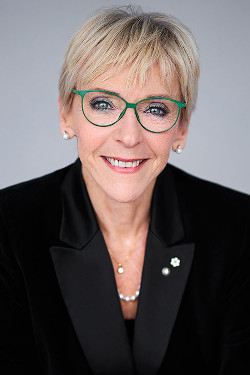
After a 40-year career as a business executive, Françoise Bertrand now dedicates her time to acting as a corporate director.
Since the spring of 2017, Ms. Bertrand has been Chair of the Board of Directors of VIA Rail Canada. In addition, she is a Strategic Advisor to the Leadership Institute, a member of the Board of Directors of Concordia University, a member of the Advisory Committee of Transurban and a member of the Ordre National du Québec.
She has served as President and Chief Executive Officer for several organizations, including the Fédération des chambres de commerce du Québec, the Canadian Radio-television and Telecommunications Commission (CRTC) and the Télé-Québec broadcasting corporation. She is a former dean of Université du Québec à Montréal. She also spent a few years working for consulting firms, notably for KPMG and as a partner with Groupe Secor.
Françoise Bertrand holds a bachelor’s degree in sociology from Université de Montréal and a master’s degree in environmental studies from York University. She capped off her academic career at the Institute of Corporate Directors.
Throughout her career, Ms. Bertrand has been recognized with several significant honours, most notably, Officer of the Order of Canada, Knight of the National Order of Québec and Chevalier of the Legion of Honour of France. She also received an honorary doctorate from Concordia University and was awarded the title of Fellow by the Institute of Corporate Directors (ICD). In 2020, Françoise Bertrand received the title of Commander of the Ordre de Montréal.
PO Box 8116 Succ. Centre-Ville
Montreal, QC H3C 3N3
 | |
| Company type | Crown corporation |
|---|---|
| Industry | Rail transport |
| Founded | January 12, 1977 |
| Headquarters | Place Ville Marie, Montreal, Quebec , Canada |
Area served | Canada |
Key people | Françoise Bertrand (Chairman), Mario Peloquin (CEO) |
| Revenue | |
| Total assets | |
| Owner | Government of Canada |
Number of employees | 3,234 (2020) |
| Website | www |
 Geographic map of the Via Rail system | |
| Overview | |
|---|---|
| Stations called at | 378[2] |
| Reporting mark | VIA |
| Dates of operation | 1977–present |
| Predecessor | Passenger services operated by the Canadian National Railway and the Canadian Pacific Railway, as well as other smaller companies |
| Technical | |
| Track gauge | 1,435 mm (4 ft 8+1⁄2 in) standard gauge |
| Length | 12,500 kilometres (7,800 mi) |
Via Rail Canada Inc. (reporting mark VIA) (/ˈviːə/), operating as Via Rail or Via (stylized as VIA Rail), is a Canadian Crown corporation that is mandated to operate intercity passenger rail service in Canada.
Via Rail operates over 500 trains per week across eight Canadian provinces and 12,500 kilometres (7,800 mi) of track, 97 percent of which is owned and maintained by other railway companies, mostly by Canadian National Railway (CN). Via Rail carried approximately 3.3 million passengers in 2022, 96 per cent of which were along the Corridor routes connecting the major cities of the Quebec City–Windsor Corridor, and had an on-time performance of 82.6 percent.[3] Attracting international tourism forms an important part of Via Rail's long distance trans-continental services.[4][5]
History
Background

Yearly passenger levels on Canada's passenger trains peaked at 60 million during World War II. Following the war, the growth of air travel and the personal automobile caused significant loss of mode share for Canada's passenger train operators. By the 1960s Canadian National Railway (CN) and the Canadian Pacific Railway (CP) found that passenger trains were no longer economically viable. CP sought to divest itself of its passenger trains, but federal government regulators and politicians balked, forcing them to maintain a minimal service through the 1970s, with the government subsidizing up to 80 percent of losses. CN, being a Crown corporation at that time, was encouraged by the federal government and political interests to invest in passenger trains. Innovative marketing schemes such as Red, White, and Blue fares, new equipment such as scenic dome cars and rail diesel cars, and services such as Rapido and the UAC TurboTrain trains temporarily increased numbers of passengers, reversing previous declines.[6]: 4–5
These increases proved temporary; by 1977, total passenger numbers had dropped below five million. The decline of passenger rail became a federal election issue in 1974 when the government of Pierre Trudeau promised to implement a nationwide carrier similar to Amtrak in the United States. Starting in 1976, CN began branding its passenger services with the bilingual name Via or Via CN. The Via logo began to appear on CN passenger locomotives and cars, while still carrying CN logos as well. That September, Via published a single timetable with information on both CN and CP trains, marking the first time that Canadians could find all major passenger trains in one publication. In 1977, CN underwent a dramatic restructuring when it placed various non-core freight railway activities into separate subsidiaries, such as ferries under CN Marine, and passenger trains under Via Rail which was subsequently renamed Via Rail Canada.[6]: 6–9
Formation and early years

On 12 January 1977, CN spun off its passenger services as a separate Crown corporation, Via Rail Canada. At its inception, Via acquired all CN passenger cars and locomotives. Following several months of negotiation, on 29 October 1978, Via assumed all CP passenger train operations and took possession of cars and locomotives. Passenger train services which were not included in the creation of Via Rail included those offered by BC Rail, Algoma Central Railway, Ontario Northland Railway, Quebec North Shore & Labrador Railway, various urban commuter train services operated by CN and CP, and remaining CN passenger services in Newfoundland. At this time, Via did not own any trackage and had to pay right-of-way fees to CN and CP, sometimes being the only user of rural branch lines.[citation needed]
Via initially had a tremendous variety of equipment — much of it in need of replacement — and operated routes stretching from Sydney, Nova Scotia to Prince Rupert, British Columbia and north to Churchill, Manitoba. Over 150 scheduled trains per week were in operation, including transcontinental services, regional trains, and corridor services.[citation needed]
While Via remains an independent federal Crown corporation mandated to operate as a business, it is hindered by the fact that it was created by an Order in Council and not from legislation passed by Parliament. Had Via been enabled by legislation, the company would be permitted to seek funding on the open money markets as other Crown corporations such as CN have done in the past. It is largely for this reason that critics say Via—like Amtrak in the United States—is vulnerable to federal budget cuts and continues to answer first to its political masters, as opposed to the business decisions needed to ensure the viability of intercity passenger rail service.[7]
1980s
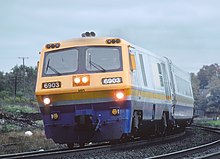
In 1981, Prime Minister Pierre Trudeau's government endorsed Minister of Transport Jean-Luc Pépin's plan which slashed Via's budget, leading to a 40 percent reduction in the company's operations. Frequently sold-out trains such as the Super Continental and the popular Atlantic were discontinued. The retrenchment of the former reduced Via to operating only one transcontinental train, The Canadian.[citation needed]
Via also sought to reduce its reliance on over 30-year-old second-hand equipment and placed a significant order with Bombardier Transportation for new high-speed locomotives and cars which would be used in its corridor trains. The LRC (Light, Rapid, Comfortable) locomotives and cars used advanced technology such as active tilt to increase speed, but proved troublesome and took several years to work out problems (by 1990 only a handful of LRC locomotives remained in service which were subsequently retired by the arrival of the GE Genesis locomotives in 2001).[citation needed]
The election of Brian Mulroney's Progressive Conservative government in 1984 brought an initial friend to Via, when several of Mulroney's commitments included rescinding the Via cuts of 1981 by restoring the Super Continental (under pressure from his western caucus), and the Atlantic (under pressure from his eastern caucus and then-Saint John mayor Elsie Wayne). Prime Minister Mulroney's government gave Via funding to refurbish some of its cars, and purchase new locomotives, this time a more reliable model from General Motors diesel division.[citation needed]
It was during this time on 8 February 1986, that Via's eastbound Super Continental collided with a CN freight train near Hinton, Alberta, as a result of the freight train crew missing a signal light, resulting in 23 deaths.
By the late 1980s, inflation and other rising costs were taking their toll on federal budgets and in the Mulroney government's 1989 budget, Via again saw its budget slashed by $1 billion,[8] surpassing even the 1981 cuts under Trudeau.
1990s
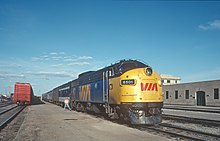
Minister of Transport Benoît Bouchard oversaw the reduction in service on 15 January 1990, when Via's operations were reduced by 55 percent.[citation needed] The privatization of CN rail in 1995 also negatively affected service as it resulted in an effective monopoly, with Via trains having to yield to CN trains.[8]
Services such as the Super Continental were again discontinued, along with numerous disparate rural services such as in Nova Scotia's Annapolis Valley and Cape Breton Island, western Canada, and in the corridor. The Canadian was also moved from its home rails on CP to the northerly CN route (previously plied by the Super Continental). The shift to the less populated route between Toronto and Vancouver severed major western cities such as Regina and Calgary from the passenger rail network and flared western bitterness toward the Government of Canada.[citation needed]
The official justification for the rerouting was that the trains would serve more remote communities, but the concentration of ridings held by the Progressive Conservatives along the CN route attracted the charge that the move was chiefly political. Harvie André, one of Alberta's federal cabinet ministers who represented Calgary, stated publicly that he did not care if he never saw a passenger train again in his life.[citation needed]
The Mulroney cuts allowed Via to consolidate its fleet of cars and locomotives, resulting in a fleet of refurbished stainless steel (HEP-1 and HEP-2 rebuilds) and LRC cars, as well as rationalizing its locomotive fleet with GM and Bombardier (LRC) units.[citation needed]
Via was not spared from further cutbacks in Jean Chrétien's Liberal government elected in 1993. Minister of Finance Paul Martin's first budget in 1994 saw further Via cuts which saw the popular Atlantic dropped from the schedule, focusing the eastern transcontinental service on the Ocean. CP had sold off a large portion of track the Atlantic had operated on and, as Via at that time was only mandated to provide passenger services on tracks belonging to CN or CP, the route was discontinued.[citation needed] This move was seen as somewhat controversial and politically motivated as the principal cities benefiting from the Atlantic's service were Sherbrooke, Quebec, and Saint John, New Brunswick, where the only two Progressive Conservative Party Members of Parliament in Canada were elected in the 1993 federal election in which Chrétien's Liberal Party took power. The Ocean service which was preserved currently operates on track between Montreal and Halifax running through the lower St. Lawrence River valley and northern New Brunswick. The Minister of Transport in Chrétien's government at the time, Douglas Young, was elected from a district that included Bathurst, New Brunswick, on the Ocean's route. A remote Via service to Quebec's Gaspé Peninsula, the Chaleur was also spared from being cut at this time, despite carrying fewer passengers than the Atlantic.[citation needed]
Renaissance funding

By the late 1990s, with a rail-friendly Minister of Transport, David Collenette, in office, there were modest funding increases to Via. Corridor services were improved with new and faster trains, a weekly tourist train, the Bras d'Or, returned Via service to Cape Breton Island for the first time since the 1990 cuts, and a commitment was made to continue operating on Vancouver Island, but western Canada continued to languish with the only service provided by the Canadian and a few remote service trains in northern BC and Manitoba.[citation needed]
In a significant new funding program dubbed "Renaissance", a fleet of unused passenger cars which had been built for planned Nightstar sleeper services between locations in the United Kingdom and Continental Europe via the Channel Tunnel were purchased and adapted following the cancellation of the Nightstar project. The new "Renaissance" cars were swiftly nicknamed déplaisance ("displeasure") by French-speaking employees and customers, due to early problems adapting the equipment for Canadian use. Doors and toilets froze in cold Atlantic Canada temperatures, resulting in delays and service interruptions.[9] New diesel-electric P42DC locomotives purchased from General Electric (GE) allowed the withdrawal of older locomotives, including remaining LRCs. LRC passenger cars were retained and continued to provide much of the Corridor service. This expansion to Via's fleet has permitted scheduling flexibility. Additionally, many passenger stations have been remodelled into passenger-friendly destinations, with several hosting co-located transit and regional bus hubs for various municipalities.[citation needed]
2000s
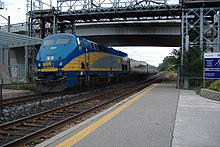
On 24 October 2003, federal Minister of Transport David Collenette announced $700 million in new funding over the next five years. This funding was below the $3 billion needed to implement a high-speed rail proposal in the Quebec City-Windsor Corridor nicknamed ViaFast; however, the funding was intended to "provide for faster, more frequent and more reliable passenger service across Canada... [preserving] the option for higher speed rail, such as the Via Fast proposal," said Collenette. This new project was to be called "Renaissance II".[10]
On 18 December 2003, Liberal Prime Minister (PM) Paul Martin froze federal spending on all major capital projects, including Via's five-year $700 million "Renaissance II" program announced just six weeks earlier by outgoing PM Chrétien's administration. Critics of Martin's cuts claimed that he was in a conflict of interest as his family through Canada Steamship Lines and various subsidiary and affiliated companies had once had a significant investment in the Voyageur Colonial Bus Lines, an intercity bus line in Quebec and eastern Ontario that was a key competitor of Via.[citation needed]
Routes cut under the Martin government included the seasonal Bras d'Or tourist train, which ran for the last time in September 2004, and the Montreal-Toronto overnight Enterprise, which was discontinued in September 2005. The Sarnia-Chicago International was also discontinued in April 2004 by Amtrak. Via's portion of the route from Toronto-Sarnia remained in operation as Via was able to use their own equipment to operate the train.[citation needed]
Sponsorship scandal
The federal Auditor General's report released on 10 February 2004 showed what appeared to be a criminal misdirection of government funds intended for advertising to key Quebec-based supporters of the Liberal Party of Canada. Included in the Auditor General's report was the fact that Via was used as one of several federal government departments, agencies, and Crown corporations to funnel these illicit funds. Forced to act on the Auditor General's report due to its political implications, Martin's government suspended Via President Marc LeFrançois on 24 February 2004, giving him an ultimatum of several days to defend himself against allegations in the report or face further disciplinary action.[citation needed]
Several days later during LeFrançois's suspension, former Via marketing department employee Myriam Bédard claimed she had been fired several years earlier when she questioned company billing practices in dealing with advertising companies. (According to CBC News, an arbitrator's report later concluded that Bédard had voluntarily left Via.) She was publicly belittled by Via CEO Jean Pelletier in national media on 27 February 2004. Pelletier retracted his statements but on 1 March, Pelletier was fired. By 5 March, after failing to defend himself adequately against the allegations in the Auditor General's report, LeFrançois was fired as well.[citation needed]
Increasing problems and reinstated funding

The reversal of funding in 2003 led to a backlog of deferred maintenance and left Via unable to replace or refurbish life-expired locomotives and rolling stock. Conversely, Via ridership increased from 3.8 million in 2005 to 4.1 million in 2006.[11] On 11 October 2007, Finance Minister Jim Flaherty announced federal government funding of $691.9 million over five years (of which $519 million was for capital projects and the remainder additional operating funding). The capital funding was earmarked to refurbish Via's fleet of 54 F40PH-2 locomotives to meet new emissions standards and extend their service lives by 15–20 years, refurbish the interiors of LRC coaches, reduce track capacity bottlenecks and speed restrictions in the Windsor-Quebec City Corridor, and make repairs to a number of stations across the network.[12]
This announcement was similar in content to the previous "Renaissance II" package, and once again was criticized for not including new equipment or funding for services outside the Windsor-Quebec City Corridor. Shortly afterwards, documents obtained by the Canadian Press under the Access to Information Act revealed that delays due to equipment failures had risen by 60 percent since the previous year. The company attributed this to problems with the aging F40 locomotive fleet.[13]
On 27 January 2009, the Government of Canada's 2009 Economic Action Plan increased funding to Via by $407 million to support improvements, including increased train frequencies and enhanced on-time performance and speed, particularly in the Montreal-Ottawa-Toronto corridor.[14]
On 21 July 2009, Via began cancelling all trains in anticipation of an engineers' strike, which officially began at midnight on 24 July. Engineers had been without a contract since 31 December 2006.[needs update] Full service resumed on 27 July.[15] An additional strike by the Canadian Auto Workers (CAW) union, representing around 2,200 employees, was planned to begin on 4 July 2010, but was called off after the union and Via reached a three-year contract.[16]
2010s

Via experienced more service cuts at the dawn of the 2010. In March 2011, the daily Victoria–Courtenay The Malahat RDC service on Vancouver Island was suspended indefinitely due to deteriorating track (it has yet to resume). By 27 June 2012, Via announced additional service cuts due to funding issues:
- The Canadian was reduced from three days a week to two days a week beginning November 2012; service operated twice weekly November–April and thrice weekly May–October until 2019. In 2019, only two trains per week operated on the full route, while the third train ran only between Vancouver and Edmonton once a week in each direction.
- The Ocean was reduced from six days a week to thrice weekly beginning October 2012.
- Corridor services west of Toronto were reduced, with weekend service reductions to Montreal and Ottawa, Ontario.[17]
- Corridor services to Sarnia and the Niagara region were reduced to once daily in October 2012, with additional taking effect in July 2012. Sarnia was left with a single daily round-trip.[18] Niagara Falls lost all service except the joint Amtrak-Via daily New York City-Toronto Maple Leaf service,[19] although Toronto regional commuter service was later provided by GO Transit.
- Corridor services to Kitchener,[20] London,[21] and Windsor[22] were reduced starting in October 2012, with at least two daily round trips surviving.
- In September 2013, the Gaspé service, which had been "bustituted" in 2011, was suspended indefinitely.[23]
To address declining on-time performance due to freight train traffic on Via routes, MP Olivia Chow drafted a private member's bill in 2014 that would reorganize the company and allow the government to force freight rail carriers to give scheduling priority to public passenger rail. However, as with most private member's bills, it was not passed.[24][25]
Service improvements
The Quebec-Windsor corridor was the focus of service restorations and implements. A direct Ottawa-Quebec City train was restored, with additional trips between Ottawa, Montreal and Toronto being added. In 2016, LRC passenger cars used for the corridor were refurbished; in the Via 1 class, this included single seating.

In March 2017, Via announced the release of a new category of rail pass valid for the month of July 2017 (corresponding to Canada's sesquicentennial celebrations) for youth aged 18–25, costing $150 (several hundred dollars cheaper than a comparable rail pass would typically cost). A larger than expected response resulted in the temporary loss of functionality for Via's website. Despite plans to cap the number of passes sold at 1867 (the year of Canadian Confederation), over 4,000 passes were ultimately sold. The company received significant backlash, as it initially appeared there was no limit on the number of passes available.[26]
Extreme winter conditions had always been an operational hazard for Via, with the Ottawa routes and Canadian being most vulnerable.[27] Equally, summer repairs and construction often delayed trains systemwide, even though schedules were regularly adjusted in an attempt to minimize delays.[27]
However, by 2018, freight traffic on the heavily used CN lines had become a significant concern for maintaining on-time service.[28][29] This issue arose due to typical siding sizes, which were not long enough to accommodate modern freight trains. Passenger trains were consequently placed on sidings whenever two trains passed (rather than freights), which meant that passenger trains did not have priority on CN lines.[30][31] The issue existed in all parts of the Via network, although it became most extreme on the Canadian, where delays increased from an average of five hours to as much as 50 over the four-day journey.[32][31][30] Via ultimately addressed the issue by eliminating its late policy on its cross-Canada trains but retaining it for the Corridor routes.[33][29] However, Via continues to compensate inconvenienced guests with necessary hotel accommodations prior to the journey, as well as ensuring continued transportation where a connection to a second Via train had been missed.[29] As such, compensation costs were factored into Via's 2018 budget.
By the end of 2018, the full route time on the Canadian had been increased twice to absorb freight delays.[28][34][29] The second extension – to five days – has been mostly successful in decreasing delays, and also allowed for a daytime transit of Hells Gate in BC, previously transversed overnight in the dark. The scheduled increased running time actually resulted in the Canadian arriving early on several occasions.[35][36] However, Toronto–Vancouver service frequencies were reduced to only twice weekly during peak summer period, with a third Toronto–Edmonton run suspended entirely. [clear]
On 12 December 2018, Via announced that it had awarded a contract to Siemens Canada for 32 train sets to replace the entire Quebec City-Windsor Corridor fleet.[37] This marked the completion of a procurement process launched following the 2018 federal budget, which allocated funding for the fleet replacement. During the request-for-proposals stage, Via had narrowed the potential suppliers down to Siemens, Bombardier, Talgo and Stadler Rail. Siemens was ultimately selected after finishing first on the key criteria, which included the ability to deliver in a timely fashion, the quality of the product offering, and the price. The new fleet will consist of Siemens SC-42 locomotives hauling a combination of coaches, business-class cars, and cab cars from the Siemens Venture series to allow bi-directional operation. The trains will be built at Siemens plant in Sacramento, California, and Siemens committed to including at least 20 percent Canadian content in the final product. The order includes an option for an additional 16 train sets to be exercised if the federal government approves Via's high-frequency dedicated-corridor project.[38] The first train set is to be delivered for testing by winter 2021, with the first sets in service by 2022 and all trains in service by 2024. The delivery of the new trains will allow Via to retire LRC and Renaissance equipment from the corridor, and re-allocate the HEP2 and corridor-based HEP1 cars to other parts of the network.
2020s

On October 30, 2021, Via Rail implemented a mandatory COVID-19 vaccine policy in line with new Transport Canada regulations in response to the COVID-19 pandemic, which required all Via Rail staff and passengers aged 12 and older to be fully vaccinated against COVID-19 to travel aboard Via Rail trains. Until November 30 a negative COVID test was also considered an alternate to show proof of vaccine prior to boarding.[39]
On March 9, 2022, Minister of Transport Omar Alghabra announced that the federal government would seek private proposals for operation of the proposed High Frequency Rail corridor.[40] Labour union Unifor criticized this move, calling it a first step toward eventual privatization of Via Rail, and launched the Get Canada Back on Track campaign to raise awareness and call for "a legislative framework that protects public, accessible, safe passenger rail and directs immediate public investments" to service improvements.[41][42]
Insignia
In addition to using commercial logos, Via Rail is one of several Crown corporations that has been granted heraldic symbols by the Canadian Heraldic Authority.
The coat of arms was granted on May 15, 2020, and presented by Canada's Chief Herald.[43]
An heraldic badge was approved for use at the same time as the coat of arms. The badge design follows the design of a law enforcement agency badge in Canada, denoting the responsibilities of Via Rail Police Service. The Royal Crown indicates that Via Rail has police constables appointed for the enforcement of the laws relating to the protection of persons and property.[43]
A flag was also granted by the Canadian Heraldic Authority. It is black and charged with Via Rail's badge.[43]
Budget and management
Via is operated as an independent crown corporation and receives a subsidy from the Minister of Transport to provide service to remote communities. Via operates more than 500 trains per week from coast to coast. The sum of CA$369 million was earned from passenger revenues in 2018. Over 4.74 million passenger voyages were taken in 2018. An on-time ratio of 71 percent was achieved in that year. Over 3,115 persons were employed by Via by the end of 2018.
Via president Yves Desjardins-Siciliano stated that the subsidy for passenger rail travel in Canada in 2015 was about 200 percent: for every $1 travellers spend on fares, Canada pays $2 in subsidy.[44]
As of May 2019, the chair of the board of directors is Françoise Bertrand. The Annual accounts of Via are audited to GAAP principles by the Auditor-General of Canada, under the Financial Administration Act. As a federal Crown corporation, Via Rail Canada Inc. operates under the Canada Business Corporations Act and is subject to income taxes, should a profit ever be declared by it. The corporation had $9,300,000 in share capital as of 2018. Via also received $394.4 million of government funding in 2018.[citation needed]
Expansion plans
Maritimes
Via has explored the introduction of daily regional service in Nova Scotia and New Brunswick (connecting Halifax, Moncton, and Campbellton) to complement the thrice-weekly Ocean service to Montreal. As of 2017, Via's statement was that it was "exploring an eastern intercity corridor service" and that further developments were dependent on infrastructure upgrades and equipment testing.[45]
Via has also expressed interest in operating commuter rail service on CN tracks in Halifax that would run from the city's downtown station as far as Windsor Junction.[45][46] However, in June 2019, Halifax regional council voted unanimously to direct staff "not to pursue commuter rail service further ... due to infrastructure requirements and associated financial implications, as well as operational considerations and restraints".[47][48]
High-frequency rail project
Via developed a $4.4 billion high-frequency rail (HFR) service plan as a response to delays faced by sharing tracks with freight trains. The plan opts for a dedicated track between Toronto, Ottawa, Montreal, and Quebec City, offering more frequent trains (although running at conventional speeds). In Ontario, Via would run a new rail line on currently underused tracks from Toronto to Ottawa through Peterborough instead of Kingston. In Quebec, corridor trains would travel from Montreal to Quebec City through Trois-Rivières on the north shore of the St. Lawrence River rather than on the south shore through Drummondville.[25] Via claimed this would allow them to run more trains in the corridor, reduce trip times by 25 percent and improve on-time performance to over 95 percent.[49]
Feasibility studies were funded by the federal government in the 2016–2018 budgets, and the 2018 budget allowed for the funding of the fleet replacement portion of the plan, though not the dedicated rail lines.[50] Contrary to expectations, the 2019 federal budget did not include a final decision for new funds for HFR.[51] However, in January 2020 Via announced the hiring of a joint venture of engineering firms AECOM and Arup to undertake a detailed engineering study of the proposal.[52] The Toronto city council passed a motion supporting the project on March 30, 2023.[53]
Service suspensions
Two former Via routes—The Malahat (service ended in 2011) and Chaleur (service ended in 2013)—are currently suspended due to poor track conditions. Via plans to reintroduce service once track upgrades have been completed.[45] The Quebec government announced funds for repairs to Chaleur trackage in 2017, with a completion date stated only as being "several years away."[54] No concrete plan to restore trackage along The Malahat has been announced as of 2020.

The Winnipeg–Churchill train was disrupted by severe spring flooding on 23 May 2017, when the Hudson Bay Railway tracks were damaged beyond standard maintenance. Winnipeg–Gillam service continued.[55] OmniTRAX, the original owner of the track, refused to make the repairs, saying that the track was no longer viable, despite the matching federal subsidy.[56] The railroad was Churchill's only land link to southern Canada, and its loss resulted in significant cost-of-living increases for residents along the corridor (a stranded train was removed by ship in October 2017).[56]
Service to Churchill was restored in late 2018, after the tracks, Churchill port, and Churchill marine tank farm were purchased by Arctic Gateway Group.[57][58] The federal government assisted in the purchase with $74 million of dedicated northern infrastructure money up front and an additional commitment of $43 million over 10 years.[59][57] To restore passenger rail service before winter, Arctic Gateway repaired 29 washouts in 35 days. Although a special Via train arrived in Churchill on 1 November, the first regular Via train arrived in Churchill on 4 December, 560 days after service initially ceased.[60][61]
On February 13, 2020, following several days of blockades during the nationwide Coastal GasLink Pipeline protests, Via Rail announced that it would be shutting down most of its passenger train service across Canada until further notice, with the exception of the Sudbury–White River train line and the Winnipeg–Churchill train between Churchill and The Pas.[62][63][64] Later in 2020, in response to the COVID-19 pandemic, nearly all Via Rail trains were suspended with the exception of the Winnipeg-Churchill train as well as one train daily on each route within the corridor.[65][66] Along with the previous protest-related service suspensions, it is the most extensive temporary reduction of service in Via Rail's history.
Travelling on Via
Travel on Via varies by region as much as class. Many of Via's policies and protocols are the product of running a national train system with varying pressures and needs of different passengers, communities, and contexts. The results are wide-ranging travel experiences depending on the distance and location of the journey.
Unscheduled stops
Some Via routes outside the corridor offer the option of unscheduled stops at places where there is no station. With 48 hours notice, a passenger can request to entrain or detrain at a specified milepost. This option is available on all of the Adventure Routes, as well as the Canadian between Capreol and Winnipeg.[67]
Classes of service
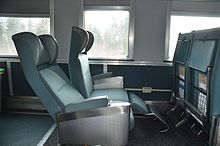
- Escape Fare: Discounted seats from economy class, with restrictions on refunds and exchanges.
- Economy: Economy class seating in coach cars.[68] Snacks and beverages are sold by employees with service carts, in a lounge car, or in a restaurant car. Free Wi-Fi access is provided in the Corridor and on the Ocean.[69]

- Business: (formerly called Via 1): First-class seating available on most Corridor trains in southern Quebec and Ontario.[70]
- Touring: Available on the Skeena only in peak travel months.[71]
- Sleeper Plus: Sleeping accommodations aboard overnight trains. This service class was formerly known as Sleeper in some cases, including on the now-suspended Chaleur.[72][73] Each car has access to a washroom and, optionally, a shower. Access to business lounges where available or the Sleeper Plus Lounge in Halifax is available on departure day.
- Prestige: Available on the Canadian only. In addition to the Sleeper Plus amenities, includes modernized luxurious sleeping accommodations at the rear of the train.
On board
Amenities

Smoking is prohibited on all Via trains. Smoking tobacco has been banned on the Corridor routes since 1993[74] and this policy was gradually extended to all trains, while smoking cannabis was banned on all Via routes on the same day it was made legal in Canada. The last remaining on-board smoking was permitted in a smoker's lounge on some long-distance routes, only at certain times of day until 2002.[75]
Washrooms are provided for each car. On sleeper cars, every private room has its own separate washroom.
Food service varies by train. All trains besides the Sudbury–White River train offer snacks, light meals, and both alcoholic and non-alcoholic beverages for purchase. Long-distance trains offer traditional sit-down dining and full meals to sleeper class passengers. Economy-class passengers can purchase hot take-out meals prepared in the dining car on long-distance trains during the peak season, and eat in the sit-down dining car in the off-peak.[76]
Complimentary Wi-Fi service is available in the Corridor.[77][78][79] Via was the first North American transportation service to offer Wi-Fi to its passengers in early 2006, and was one of the first in the world to do so.
Wi-Fi service has been added to the Ocean train in the service cars,[80] although connections are unreliable in most places outside urban centres.
Accessibility and safety concerns
All Via trains are capable of accommodating wheelchairs, although capacity is limited.[81]
Routes and connections

Via operates in the provinces of Alberta, British Columbia, Manitoba, New Brunswick, Nova Scotia, Ontario, Quebec, and Saskatchewan. The only province or territory connected to the continental railway network and not served by Via is the Northwest Territories. Newfoundland and Labrador, Nunavut, Prince Edward Island, and Yukon have no rail connections to the continental network and thus no Via service.
Via operates over 475 trains per week over 19 routes, marketed in four broad categories:[82]
- Ontario and Quebec/Corridor service: comprising frequent regional and local trains between major cities in a band from Southwestern Ontario to Quebec City. The vast majority of Via's trains – over 400 per week – operate here. Cities served by Corridor trains include Windsor, Sarnia, London, Toronto, Kingston, Ottawa, Montreal, and Quebec City. In 2017, corridor service accounted for 95 percent of Via's ridership and 77 percent of its revenue.[83]
- The Maritime Way/Ocean: providing long-distance service between Quebec and the Maritime provinces. In 2017, the Ocean accounted for 2 percent of Via's ridership and 3 percent of its revenue.[83]
- The Great Western Way/Canadian: providing both long-distance service between Southern Ontario and Western Canada, as well as essential rail services through Northern Ontario. In 2017, the Canadian accounted for 2 percent of Via's ridership and 20 percent of its revenue.[83]
- Adventure Routes: Five regional and long-distance routes that
offer essential rail transportation in rural northern areas. In 2017,
these routes in aggregate accounted for 1 percent of Via's ridership and
revenue.[83] The routes included in this category are:
- Jasper–Prince Rupert train (former name: Skeena) - Alberta and British Columbia
- Montreal–Jonquière train (former name: Saguenay) - Quebec
- Montreal–Senneterre train (former name: Abitibi) - Quebec
- Sudbury–White River train (former name: Lake Superior) - Ontario
- Winnipeg–Churchill train (former name: Hudson Bay) - Manitoba and Saskatchewan
Unlike Amtrak, which gives every route a specific name, most Via trains are identified only by their route number and destination. The only named Via trains are the Canadian and the Ocean. The five "Adventure Routes" were previously branded as the Skeena, the Saguenay, the Abitibi, the Lake Superior, and the Hudson Bay, respectively, and may still be referred to by these names in local usage.
Track ownership

As of 2017, the mileage makeup of Via's route network by track owner/host railway was as follows:[45][note 1]
- 84 per cent: Canadian National Railway
- 8 per cent: Hudson Bay Railway
- 4 per cent: Canadian Pacific Railway
- 3 per cent: Via Rail
- 2 per cent: Metrolinx (GO Transit)
In total, about 88 percent of Via trackage is owned by Class I railroads, 8 percent by shortline railroads, and 5 percent by government agencies.
Connections

The Maple Leaf, operating between New York City and Toronto via Albany, Buffalo, and Niagara Falls, is jointly managed by Via and Amtrak. The train operates using Amtrak equipment, but on the Canadian side of the border is staffed by Via employees and operated as a typical Via train.
Two other train routes link Canada and the US: the Adirondack (Montreal-New York) and the Amtrak Cascades (Vancouver-Seattle-Portland). While both of these routes share stations with Via at their Canadian termini, they are fully operated by Amtrak and single-ticket connections to Via trains are not offered.
Via also has connection agreements with several local and intercity bus operators, car-sharing services, and airlines. Passengers who are flying with some airlines can combine their air and rail trips under the same record locator.[85]
Rolling stock
Via owns 74 locomotives and 501 passenger cars.[86] Examples include the GMD F40PH-2 diesel locomotive and the famed "Park"-class sleeper-dome-lounge cars found on the rear of the Canadian and the Jasper–Prince Rupert train.
CN Investment Division (CNID)
Who we are
Established in 1968, the CN Investment Division (the Division), based in Montreal, manages one of the largest single-employer defined benefit pension funds in Canada and holds a long track record of solid performance.
Approximately C$17 billion is actively managed in-house by 95 employees for the CN Pension Plan’s approximately 49,200 pensioners and pension plan members. The Division also manages the assets of the CN Pension Plan for Senior Management and the BC Rail Pension Plan.
The Division’s culture is nimble, innovative, collaborative, and risk-aware. Pensioners are always at the heart of what we do.
Mailing Address
5 Place Ville Marie, Suite 1100
P.O. Box 11002
Montreal, Quebec H3C 4T2
Canada
Street Address
5 Place Ville Marie, Suite 1100
Montreal, Quebec H3B 2G2
Canada
Olivier P. A. Chouc
Eric Harvey
M. Cristina Circelli
Mélanie Allaire
Mathieu Bergeron
Leadership Team
TRACY ROBINSON
President and Chief Executive Officer
Tracy Robinson was appointed President and Chief Executive Officer of CN on February 28, 2022 and is responsible for CN’s strategic direction and leadership.
Prior to joining CN, Tracy was Executive Vice-President of TC Energy, President of Canadian Natural Gas Pipelines and President of Coastal GasLink.
Tracy’s deep experience in the railway industry stems from her 27 years at Canadian Pacific Railway. There, she served in executive roles in the commercial, finance and operating functions, including as General Manager of Transportation Services, Vice President and Treasurer, and Vice President of Marketing and Sales.
Tracy is a seasoned executive with a proven track record in the transportation industry. She is known for her ability to drive innovation and foster collaboration among diverse teams and stakeholders. Her passion for mentoring the next generation of leaders and her advocacy for inclusive leadership have further solidified her reputation as a forward-thinking leader.
She is Vice-Chair of the Board of the Business Council of Canada. She is also a member of the Campaign Committee and the Dean’s Advisory Council at the Edward’s School of Business of the University of Saskatchewan.
Tracy holds a Master of Business Administration from the University of Pennsylvania’s Wharton School of Business and a Bachelor of Commerce from the University of Saskatchewan. She received her Institute of Corporate Directors designation in 2015.
GHISLAIN HOULE
Executive Vice-President and Chief Financial Officer
Ghislain Houle was appointed Executive Vice-President and Chief Financial Officer in July 2016, based in Montreal. His responsibilities at CN include financial management, strategic planning, strategic acquisitions, and investor relations. Previously, he had been Vice-President and Corporate Comptroller since March 2016, and Vice-President – Financial Planning since March 2007.
Ghislain joined CN in September 1997 as Chief of Internal Audit. In July 1998, he was appointed Managing Director, ISP Project, a three-year initiative to improve business processes by replacing CN's administrative support systems with the SAP integrated solution. He became Vice-President and Treasurer in 2001 and in 2004, he was responsible for the integration of the Business Development Group with CN Railway Properties, which he already managed since November 2002.
Prior to joining CN, Ghislain held the position of Senior Manager in tax and audit at a major accounting firm.
Ghislain is a CPA, CA and holds a bachelor of commerce degree from Laval University and an MBA from McGill University.
REMI G. LALONDE
Executive Vice-President and Chief Commercial Officer
Remi G. Lalonde was appointed as Executive Vice-President and Chief Commercial Officer on April 18, 2024.
Based in Montreal, Remi joined CN on January 8, 2024, as Executive vice-president and Special Advisor to the CEO. Prior to CN, Remi was President and CEO of a Quebec-based forest products company. After several years at a Wall Street law firm, he joined the forest products company as a senior securities counsel. Over his tenure at the company, he served in corporate and customer focused roles, including as Senior Vice-President and Chief Financial Officer and as General Manager for a critical manufacturing facility.
Fluently bilingual in his native French as well as English, Remi holds a Bachelor of Laws and a Bachelor of Environmental Engineering from the University of Ottawa. Remi has led teams, executed strategy, managed regulatory matters, engaged with Indigenous communities and stakeholders, headed manufacturing operations, and worked with investors and suppliers. His successful track record of cross-functional experience and first-hand knowledge of the importance of supply chains, as well as his focus on business growth and sustainability, will help drive CN’s growth agenda.
DOMINIQUE MALENFANT
Executive Vice-President and Chief Information and Technology Officer
Dominique Malenfant was appointed Executive Vice-President and Chief Information and Technology Officer in September 2020. Based in Montreal, Dominique is responsible to deliver CN’s technology strategy, with a focus on automation technology and the digitalization of CN’s network and operations.
Dominique has spent nearly 30 years in global leadership roles in the transportation and rail industries. In his most recent role, Dominique was Senior Vice-President, Engineering and Chief Technology Officer at Wabtec Corporation. Prior to his position at Wabtec Corporation, Dominique held the position of Vice-President of Global Technology at GE Transportation. During his tenure at Wabtec Corporation and GE Transportation, Dominique was focused on the next generation of Precision Scheduled Railroading and Positive Train Control technologies and spearheaded a major digital industrial evolution in rail.
Previous to GE Transportation, Dominique served as Vice-President of Product and Engineering for the Transportation Propulsion and Control Business at Bombardier Transport. He also managed Bombardier Transport’s North American group, where he was responsible for Product Management, Engineering and Supply Management. He also led the Center of Expertise R&D group, and has experience in Plant Management, Engineering Quality Assurance, Systems Engineering, and Project Management.
Dominique holds a bachelor’s degree in Electrical Engineering from Laval University, Quebec.
DEREK TAYLOR
Executive Vice-President and Chief Field Operations Officer
Derek Taylor was promoted to the position of Executive Vice-President and Chief Field Operations Officer in November 2023. Derek is responsible for running CN’s operational plan and is based at CN’s operational center in Homewood, Il.
Derek is a proven strong leader in Transportation with over 20 years of experience at CN. He joined the Company as Management Trainee in Winnipeg, MB, in 2000 and since then has held progressively more senior leadership roles across the organization. He served as General Manager in Fond du Lac, WI, and in Homewood, IL, and was Vice-President, Transportation, for the Southern and Eastern Regions at different times. As Vice-President, Operational Excellence in 2022, he was responsible for driving continuous improvement across CN’s key operating metrics. Derek was appointed Senior Vice-President, Transportation in November 2022.
Derek holds a Bachelor of Arts degree from DePauw University in Indiana.
PATRICK WHITEHEAD
Executive Vice-President and Chief Network Operating Officer
Patrick Whitehead was appointed Executive Vice-President and Chief Network Operating Officer in November 2023. He is responsible for making CN’s operational plan and is based at CN’s operational center in Edmonton, AB.
Pat is an accomplished executive with over 30 years of railroad experience, over 25 of which have been in management positions in Transportation and Mechanical operations. He joined CN in 2021 as General Manager in Chicago. Prior to joining CN, Patrick was Vice-President, Transportation for Norfolk Southern Railway. Patrick was appointed Senior Vice-President, Network Operations in June 2022.
Patrick has completed the University of Pennsylvania’s Wharton School of Business Advanced Management Program and holds a Master of Science degree in Transportation Management from the University of Denver.
OLIVIER CHOUC
Senior Vice-President and Chief Legal Officer
Olivier Chouc was appointed Senior Vice-President and Chief Legal Officer on September 15, 2022. He graduated from the Faculty of Law of Université Laval in 1990 and was admitted to the Quebec Bar in 1991. He left private practice in 1998 after seven years at Ogilvy Renault, to join Abitibi-Consolidated (Donohue Inc.) as in-house counsel, where he was responsible for supporting procurement management as well as the company's real estate, litigation and intellectual property portfolio. He was also entrusted with transactional work, including with some aspect of the major transaction leading to the sale of Donohue Inc. to Abitibi-Consolidated. In 2000, he joined the CN Law Department in a counsel capacity to support real estate, supply management, as well as transactional work. He then moved to a senior counsel position with increased responsibilities in the area of mergers and acquisitions and was eventually responsible for the management of the mergers and acquisition group. In 2006, he was named Assistant Vice-President, General Counsel and Managing Partner and in 2011, he was named Vice-President, Legal.
In 2005, Olivier was named Canada's Top 40 under 40 In-House Counsel by the National Post.
Olivier is involved with charitable organizations, namely the Fondation Marie-Vincent, The Ted Nolan Foundation and the Fondation Enfants-Retour. He is currently the Chairman of the CN Employees' and Pensioners' Community Fund after ending a two year mandate as co-president.
was appointed Senior Vice-President and Chief Legal Officer on September 15, 2022. He graduated from the Faculty of Law of Université Laval in 1990 and was admitted to the Quebec Bar in 1991. He left private practice in 1998 after seven years at Ogilvy Renault, to join Abitibi-Consolidated (Donohue Inc.) as in-house counsel, where he was responsible for supporting procurement management as well as the company's real estate, litigation and intellectual property portfolio. He was also entrusted with transactional work, including with some aspect of the major transaction leading to the sale of Donohue Inc. to Abitibi-Consolidated. In 2000, he joined the CN Law Department in a counsel capacity to support real estate, supply management, as well as transactional work. He then moved to a senior counsel position with increased responsibilities in the area of mergers and acquisitions and was eventually responsible for the management of the mergers and acquisition group. In 2006, he was named Assistant Vice-President, General Counsel and Managing Partner and in 2011, he was named Vice-President, Legal.
In 2005, Olivier was named Canada's Top 40 under 40 In-House Counsel by the National Post.
Olivier is involved with charitable organizations, namely the Fondation Marie-Vincent, The Ted Nolan Foundation and the Fondation Enfants-Retour. He is currently the Chairman of the CN Employees' and Pensioners' Community Fund after ending a two year mandate as co-president.
JANET DRYSDALE
Senior Vice-President and Chief Stakeholder Relations Officer
Janet was appointed Senior Vice-President and Chief Stakeholder Relations Officer in March 2023. She drives the Company’s stakeholder engagement and communications strategies, which includes public and government affairs, media relations, corporate communications, as well as investor relations.
Janet Drysdale is a seasoned and versatile executive with nearly 30 years of cross-functional leadership having held executive positions in Finance, Sustainability, Corporate Development, and Investor Relations.
Janet has long been an advocate for the rail industry, North America’s critical supply chains, women in transportation, and the transition to a low carbon economy.
Janet is an independent director of Rumo S.A., Brazil’s largest freight railway. She also sits on the board of the Railway Association of Canada and is proud to be the executive sponsor of the Women’s Employee Resource Group at CN.
In 2020, Janet was recognized by WXN as one of Canada’s Top 100 Most Powerful Women in the executive leadership category, and by Railway Age for her leadership, collaboration, and innovation. In 2021, Janet completed the Competent Boards ESG program and certification (GCB.D).
Janet has an Honours Bachelor of Science degree from Queen’s University and Master of Business Administration (MBA) from McGill University.
JOSÉE GIRARD
Senior Vice-President and Chief Human Resources Officer
Josée Girard was appointed CN’s Senior Vice-President and Chief Human Resources Officer on August 1, 2023. Read more»
PATRICK LORTIE
Senior Vice-President and Chief Strategy Officer
Patrick Lortie was appointed Senior Vice-President and Chief Strategy Officer of CN in February 2023. Read more»
MONTREAL, Feb. 19, 2021 (GLOBE NEWSWIRE) -- Janet
Drysdale, Vice-President Financial Planning and Chantale Després,
Assistant Vice-President Sustainability, to address the RBC Global ESG
Conference on February 26, 2021 at 9:30 a.m. Eastern Time (ET).
CN will provide a live webcast of all remarks via the Investors’ section of the Company’s website, www.cn.ca/en/investors. A replay of the webcast will be available on the website shortly after the event.
About CN
CN
is a world-class transportation leader and trade-enabler. Essential to
the economy, to the customers, and to the communities it serves, CN
safely transports more than 300 million tons of natural resources,
manufactured products, and finished goods throughout North America every
year. As the only railroad connecting Canada’s Eastern and Western
coasts with the U.S. South through a 19,500-mile rail network, CN and
its affiliates have been contributing to community prosperity and
sustainable trade since 1919. CN is committed to programs supporting
social responsibility and environmental stewardship.
| Contacts: | |
| Media | Investment Community |
| Jonathan Abecassis | Paul Butcher |
| Senior Manager | Vice-President |
| Media Relations | Investor Relations |
| 1-833-946-3342 | (514) 399-0052 |
| media@cn.ca | investor.relations@cn.ca |
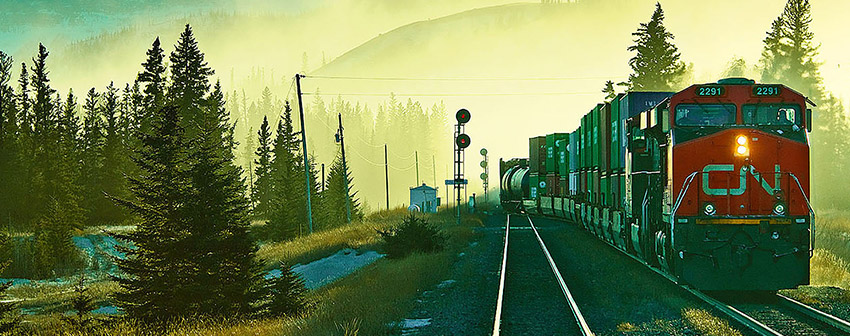
Rail
We Connect the Dots
We got our start in rail close to 100 years ago. Since then, we’ve evolved into a world-class transportation leader and the only transcontinental railway in North America. Our 20,000-mile network spans Canada and Mid-America, connecting three coasts: the Atlantic, the Pacific and the Gulf of Mexico. Our supply chain partnerships carry customer cargo all the way to Mexico City. Wherever you find CN trains, you’ll find a host of service options to help you ship more; faster, further and more cost-effectively.
The Board has oversight responsibility for the stewardship of CN and its business and is accountable to shareholders for the performance of CN. The Board has clearly delineated its role and the role of management. The role of the Board is to supervise the management of CN’s business and affairs, with the objective of creating value for shareholders and taking into account the interests of other stakeholders. Management’s role is to conduct the day-to-day operations in a way that will meet this objective.
Among its activities that derive from its stewardship and decision-making responsibilities, the Board has oversight responsibilities over:
- Strategic Planning
- Executives
- Corporate Governance
- Risk Management, Financial Reporting and Internal Controls
- Capital Allocation
- Sustainability, Environment, Safety and Security
- Pension Fund Matters
For more detailed information on these responsibilities, refer to the Management Information Circular.
 JO-ANN dePASS OLSOVSKY
JO-ANN dePASS OLSOVSKY
Corporate Director. Retired Executive Vice-President and Chief Information Officer, Salesforce.com, Inc.
 DAVID FREEMAN
DAVID FREEMAN
Corporate Director. Retired Executive Vice-President of Operations, BNSF Railway
 DENISE GRAY
DENISE GRAY
Corporate Director. Retired Director External Affairs & Government Relations, North America, LG Energy Solution Michigan Inc., U.S.
 JUSTIN M. HOWELL
JUSTIN M. HOWELL
Senior Investment Manager, Cascade Asset Management Co.
 SUSAN C. JONES
SUSAN C. JONES
Corporate Director. Retired Executive Vice President and Chief Executive Officer of the Potash Business Unit at Nutrien Ltd.
 ROBERT KNIGHT
ROBERT KNIGHT
Corporate Director. Retired Chief Financial Officer, Union Pacific Corporation
 MICHEL LETELLIER
MICHEL LETELLIER
President and Chief Executive Officer, Innergex Renewable Energy Inc.
 MARGARET A. McKENZIE
MARGARET A. McKENZIE
Corporate Director. Former Chief Financial Officer of Range Royalty Management Ltd.
 AL MONACO
AL MONACO
Corporate Director. Retired President and Chief Executive Officer, Enbridge Inc.

Paul M. Tellier
Paul M. Tellier was born in May of 1939 in Joliette, Quebec. Tellier earned degrees from the Universities of Oxford and Ottawa, sitting for the bar after graduating from the latter with a law degree. He rose through the Canadian civil service to the rank of Deputy Minister of Indian Affairs in 1979 and then Deputy Minister of Energy, Mines, and Resources in 1982. In 1985, he became the top-ranking Canadian civil servant when he took up the appointment of Clerk of the Privy Council and Secretary to the Cabinet. After seven years in this position, he became President and Chief Executive Officer of the Montreal-based Canadian National Railway (CN).
Tellier's task at CN was to lead the corporation through the painful process of privatization. When Tellier joined the company in 1992, it had been badly underperforming. The government sold off the corporation because it had become a burden on taxpayers in an age of burgeoning private enterprise and lower government expenditures.
Tellier took stock of the situation and began by laying off employees in 1998. Over the next few years, he pursued a policy of reducing the size of the CN workforce, which fell from around 36,000 when he joined the corporation in 1992 to some 17,000 by the year 2000. As a result of these reductions, productivity per employee rose by a third and revenue per employee grew some thirty percent by the end of 2000.
In the same year that he began the process of reducing the payroll, Tellier engineered the purchase of the Illinois Central Railroad to gain direct access to the United States market south of Chicago. The two railroads officially merged in 1999, and two years later, CN purchased the Wisconsin Central Railway to gain access to the upper Midwest. Tellier’s business plan of selected expansion and reductions in force allowed the Canadian National to turn a profit and enabled him to move on, which he did in December 2002.
In January 2003, Tellier joined Bombardier Incorporated, a manufacturer of railcars and airplanes on whose board he had served for five years. The unprofitable company, whose business had suffered in the wake of the September 11, 2001, terrorist attacks on the United States, brought Tellier in to turn it around. Within three months of taking charge, Tellier announced job losses in the aerospace division amounting to 3,000 out of a total of around 30,000 employees. In December 2004, after losing a boardroom battle over the future direction of the company, Tellier left the company but resurfaced in the transportation business as chairman of GCT Global Container Terminals.
Tellier was honored by Railway Age as Railroader of the Year in 1997. In 1998, he was elected “Canada’s Outstanding CEO of the Year,” and in 2003 he was named as the most respected Canadian CEO by a business survey. He was appointed Companion of the Order of Canada in 1992 and has been awarded honorary doctorates from five different Canadian universities. In 2004, the Canadian National named its tunnel between Sarnia, Ontario, and Port Huron, Michigan in his honor, a fitting tribute to his work. Tellier will be remembered as a pioneer railroader in twentieth-century railroading who promoted greater integration between the railroad systems of the United States and his native Canada.
For additional information, visit:
Canadian Railway Hall of Fame: The Paul M. Tellier Tunnel
64 S Prairie St., Suite 216, Galesburg, IL 61401
309-368-7842
king@nrrhof.orgnrrhof.org
309-368-7842
king@nrrhof.org
The Americanization of CN
The CN Rail Strike
It is day 16 of the strike at Symington Yard, the Canadian National Railway’s main hump yard in Winnipeg. It is a cold, gray, and dank day. The wind is blowing. The sound of cars from the nearby street swishes by. The workers talk amongst themselves. Strapped to the outside of their bulky winter coats are signs with the word “STRIKE” printed boldly in large letters. Sympathetic cars passing by honk their horns, and the workers nearest the street raise their hands in response to the expressions of solidarity.
Guy Bouvier, a CN employee walking the picket line, peers from the shell of his winter coat. Even though the sun is nowhere to be seen, he wears a pair of fluorescent sunglasses that would not be out of place on a ski hill.
“I hired on in ’81. There were approximately 76,000 people working at that time. In 1967 there were about 125,000 people. Right now we’re down to eighteen-five,” says Bouvier.
Behind him, a group of his fellow workers and members of the Canadian Auto Workers union (CAW) huddle by a burning barrel located on the perimeter of the yard. A couple of them throw pieces of scrap lumber into it. Sparks fly up, but are quickly blown out by the brisk, chill Manitoba wind. Nearby, a City of Winnipeg police caravan sits silently, watching over the entrance to Symington Yard like a bulbous metal spider.
The workers have been on strike since February 20, when an initial offer from CN was scrapped. But since a deal has by now been reached, the question is why CN rail workers from Winnipeg to Montréal felt it was time to send a message to CN’s corporate headquarters.
The Privatization of the CNR
Canadian National was born out of a series of smaller rail lines that, after running out of funds, were then bought by Robert Borden’s Conservative government back in 1918. The political machinations and motivations behind the nationalization of the Canadian railways were complex. Aside from rescuing the banks–the creditors of the bankrupt rail companies–a government-owned national railway system would be better able to provide cheaper rates for businesses that wanted to distribute their goods as efficiently as possible than would a privately-owned monopoly–which was the threat that the Montréal-based Canadian Pacific Railway posed to the Toronto business community at the time. After the dust settled and the Canadian government put its stamp on all the rail lines in Canada–over 22,000 miles of track and 100,000 employees–CN had became one of the world’s largest railroads.
“To put it in a historical perspective, CN was the flagship, premier Crown corporation of this country,” says Robert Bourrier, a CAW system health-and-safety legislative representative and CN history buff. “Out of it came TCA [TransCanada Air Lines, the forerunner of Air Canada] and the CBC.”
CN, however, almost always operated in the red, and it was rare that it showed a profit. In the late 1970s, the federal government forgave CN’s loans, which allowed the company to show a modest profit. But by the eighties, with increasing competition from other railroad companies and the trucking industry, there was a movement by some in the federal government to make CN more competitive. Many believe that these moves were taken as the first steps in the eventual privatization of CN.
“In the late eighties there was a big move to deregulate the railway industry under such banners as ‘Freedom to Move,’ ” Bourrier explains. The Railway Safety Act was gutted and other legislative steps were taken to deregulate the railroad industry and bring it ostensibly more in line with the relatively few safety regulations governing the trucking industry. The current rules governing safety are “company-written,” states Bourrier. “[They] were presented by the Railway Association of Canada … the railway companies basically re-wrote the rules,” allowing them “the flexibility to do what they want.”
CN underwent a massive structural change, as well. It divested itself of many of its other businesses, like the Toronto’s CN Tower, in order ostensibly to concentrate fully on the railroad business and to reduce its debt. Advisors also believed CN had overcapacity in certain rail lines that were underutilized and, thus, uncompetitive. This belief led to the closure of rail lines in rural areas, once the sole raison d’être of many a small town. Thousands of miles of rural track were ripped up, leaving nothing but beds of gravel to show where there were once rail lines.
“You have CN shedding those lines that historically were built to service our Canada … and having them spun off into short-line operations … or shut down altogether,” says Bourrier.
The move to make CN competitive eventually led to the conclusion that it would be best if CN were privatized. This was foreshadowed when Paul M. Tellier, a top-level Liberal bureaucrat, became CN’s president and CEO in 1992. “[Tellier’s] mandate, in my opinion, was to privatize CN,” states Bourrier.
Actual privatization happened in 1995, when the federal Liberal government made CN a publicly traded company. “They figured out an approximate value and … sold [CN] off,” says Derek Black, a retired machinist with a 30-year history at the company.
CN’s website claims that the privatization of CN “was the largest and most successful privatization in Canadian history,” selling all the offered shares within a single day, pouring $2.2 billion into the federal government’s coffers.
Canadian in Name Only?
Around the same time as the privatization of CN, according to Black, laws governing the percentage of foreign ownership changed, allowing for greater foreign investment in Canadian companies.
“The end result was that you had more and more shares ending up in American hands,” Black comments. He estimates that the percentage of American and foreign ownership of CN shares is now between 80 and 90 per cent. “It’s a publicly traded company,” adds CAW national representative Doug Olshewski. “But 80 per cent of the stock is held by Americans.”
CN’s next move was interesting: It purchased Illinois Central, a major American railroad company. Illinois Central is based out of Chicago and runs south to New Orleans. But whether CN really purchased Illinois Central, or if it was the other way around, remains an open question.
The Illinois Central purchase of was just the first manifestation of CN’s newfound thirst for acquisitions. It went on a buying spree, snapping up smaller, class-2 American railroad companies, like Wisconsin Central. The goal was to increase CN’s distribution control over North America by having connections to the three coasts: east, west, south. Black maintains that more was happening at CN than just these acquisitions: there was a re-calibration of management as well. “In order to cement these mergers and purchases, they began a process of integrating the management,” he explains. Tellier was still CEO at the time of the Illinois Central purchase; but the merger with Illinois Central was accompanied by the arrival of E. Hunter Harrison, president and CEO of Illinois Central, who then became Tellier’s number two man. In 2003, Harrison became the chief. Since then, there appear to have been more and more Americans in senior management positions.
In other words, CN was fast losing any connection to its Canadian roots. On the day of CN’s privatization, Black organized a New Orleans-style funeral for CN: a perhaps perverse but fitting American funeral for the demise of a Canadian institution.
Business American-Style
CN soon started changing its business practices drastically in order to cut costs and boost profits.
“Once it was privatized and out of the control of the federal government, [CN] began a very aggressive campaign of contracting the repair and maintenance work out and shipping it south of the border to little shops and plants in the United States,” Black says. “All of a sudden you find the work disappearing, and you’d have a tough time figuring out where the work had gone.”
Black and his fellow workers also noticed another, sleazier change in CN’s corporate attitude. “They became much more sophisticated in some of the wheeling and dealing going on. There were rules and regulations under the collective agreements that forbade the contractingout of work. [CN] began to, quote-unquote, “scrap” locomotives, and they would sell them to an American firm. The American firm would then move them into Montreal … into a former CN shop. There [the locomotives] would be totally re-built, shipped back to the American firm, and then leased back to Canadian railways.”
Black then chooses his words carefully: “That’s what I would refer to as a really ‘sharp’ practice.”
Black believes that, to those pushing the privatization process, the attraction of privatization itself was more important than looking at the actual costs and value of keeping CN public. “The quality [of repair work by Americans] doesn’t stand up, the price doesn’t stand up. If it was costing $1,000 to do a job in the shop here, then it was costing them $2,000 to get [the job] done in the States.” In other words, saving money wasn’t the point of privatizing CN.
Another questionable business practice on CN’s part happened during the strike, when scab workers were imported from the U.S. to fill Canadian workers’ positions when the latter went on strike. According to Bill Blaikie, Member of Parliament for Transcona, historically a railway workers’ community, this violates a NAFTA provision under which no company is allowed to transfer workers from one country to another. “The [federal] government refused to do anything about it because it said this was an intra-company transfer,” says Blaikie. The federal government, he argues, was “hiding behind NAFTA. But, in fact, there were provisions in NAFTA , if the government were willing to use them … about not being able to bring workers in for the purpose of getting involved in a labour dispute.”
American-Style Management
Many CN workers believe that with the Americanization of CN came a different, more aggressive attitude to the treatment of workers. “They come from a different culture in the United States in terms of labour relations … in terms of their political [and] social views,” Bourrier explains. He describes the American managers at CN as “ruthless” by Canadian standards. “They have very little regard for Canadian rules. Whatever [rules] don’t suit them, they will try to change them.”
In addition to actively lobbying the Canadian government to change labour laws in its favour, CN has instituted some eyebrow- raising labour changes for the workers of CN themselves. First came an increased workload, which CN workers now must bear owing to the technological advances in the railroad industry and an increased need to maximize profits by lowering costs.
“What we found was that there was so much anger towards the employer that a strike was inevitable,” Olshewski says. “The company’s prime objective was to have the best operating ratio in North America … which means for every 66 cents they spend they earn a dollar. And that meant huge rationalization, speed-ups, productivity gains–all on the backs of the workers.”
Another workers’ grievance related to workplace injury. The old system was a nofault system, and the former CN management treated injuries within that context. In the U.S. system, with its emphasis on personal responsibility and its penchant for lawsuits, the employer is responsible for the workplace. Since it is in the best interest of management to avoid lawsuits, the American management imported the American method of dealing with injuries. Olshewski says the management has no sympathy: “If you get in an accident, it’s your fault.” The unfortunate result is that workers, given the choice between reporting an injury or getting suspended, tend not to report.
But the change in management style that has angered CN workers most involves the issue of discipline. Many CN workers believe they are not respected by CN management, one of the main reasons they voted down an initial contract offer between CN and their union representatives. The fact that their union recommended approval of the offer caused some anger among workers who questioned the union’s commitment.
“We have had a disciplinary policy that has been in effect for a hundred years called the Brown system of discipline, which means you get demerit marks for punishment,” says Olshewski. He says the new management didn’t want to keep the Brown system. “They said it was too hard to fire people under that system …they wanted to change arbitration procedure.”
Bourrier seems to agree that the new CN management took a harder line on discipline, adding that management “was giving suspension for very, very slight infractions.”
“It’s the way people are being treated, the lack of dignity shown to the workers, that has become a real big issue here,” Olshewski says.
Perhaps icing on the cake, Black claims he has heard American managers giving derisive slurs to Canadian CN employees, including names like “snow niggers” and “overpaid Mexicans.”
In the End
The strike has ended some time ago. According to the union’s interpretation of what was agreed to, it was a major victory for the workers, with favourable resolutions on safety and discipline issues. Others, like Hunter Harrison, took away a different understanding. The final outcome is still unclear.
STRIKE CHRONOLOGY
Dec. 31, 2002: the contract for CAW shop-craft, intermodal and clerical workers expires
Feb. 20, 2004: Nearly 5,000 CAW shop-craft, intermodal and clerical workers go on strike after rejecting a proposed contract. The contract would have provided wage and benefit increases of 9.7 per cent over three years. Union leaders recommended acceptance of the offer. The underlying reason for union members rejecting the initial offer from CN was mainly related to the issue of CN’s American-style discipline system.
March 15, 2004: CAW agrees to a tentative deal to end the strike. The deal provides for a return-to-work bonus of $1,000 and annual salary increases of three per cent. CN also agrees to drop a new disciplinary system and go back to the one that was in place before Jan. 1, 2001.
April 12, 2004: A hostile and intimidating environment with new restrictions on flextime, more contracting out of work and threats of large permanent layoffs greeted workers when they returned to their workplaces. “The company is seeking revenge for what in their view was a costly strike,” says Rick Johnson, president of National Council 4000. A bad faith bargaining complaint against CN was being contemplated at the time of this writing.
Eric Warwaruk was born and raised on a family farm in midwestern Manitoba. He has a degree in film studies from the University of Manitoba, and is completing his M.A. thesis in communications studies at McGill University in Montreal. He currently works as a freelance writer in Winnipeg
This article appeared in the May/June 2004 issue of Canadian Dimension .




















No comments:
Post a Comment